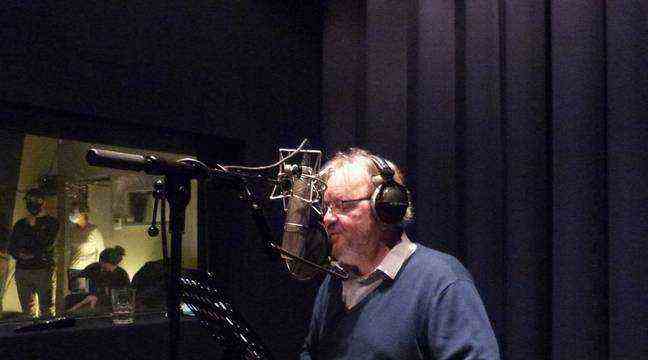“Dear travellers, please note that on the weekend of January 29 and 30, traffic is interrupted for works between Aulnay-sous-Bois and Charles-de-Gaulle. “It’s nickel, but I think you should add RER B, it would help travelers!” Sophie, mauve hair and dressed in black, then repeats the announcement at the microphone of the small cabin under the approving eye of Adrien, seated on the other side of the window, in front of the recording console. Even if the atmosphere is relaxed in this dark studio with dimmed lights, the recording of the voices of the RATP network is very professional. With one exception, Sophie, in real life, deals with station regulations at the RATP.
It is Song Phanekam, the head of the sound and visual identity of the group, who is at the origin of this initiative. “In the mid-2000s, we started adding sound to bus lines with computer-generated voices,” he says. Then we had to generalize it on all lines but we realized that it was not going well. Admittedly, it’s practical to manage, but it lacked clarity and warmth. Song Phanekam then looks at what is being done in other networks such as Berlin, London, New York, and observes that these call on human voices. At the SNCF for example, it is the actress Simone Hérault who embodies
for years the voice of the train.
Blind casting “The Voice” style
But to build its sound identity, the RATP wants to bring a little more. “At the time, it was the big fashion for telecrochets, The New Star, Pop star, star Academy, we thought that the solution was there, continues Song Phanekam. We surely have hidden talents among our 50,000 agents and we are going to appeal to them by organizing castings with blind selection. The first in 2005 attracted 500 candidates for 12 selected. Sophie, she registered, pushed by a friend, for that of 2014. “It was a little The Voice, I was selected in the first round, then in the second round, and I am now one of the twenty votes of the RATP. »
At this moment, Sophie lists the names of the stops on a bus line. A difficulty lies in the pronunciation of certain stations. “On the names of unknown or foreign-sounding personalities, we do not always know how to pronounce them, explains Song Phanekam. In these cases of doubt, we record several versions then we contact the French Academy which tells us the exact pronunciation of such a name. »
Jean-Baptiste has just replaced Sophie in the cabin. He is one of the historic voices of the RATP since this operating agent has been officiating since the 2005 casting. “As an agent, I was already making announcements into the microphone, so I said to myself why not”, recalls he. The start is a bit laborious due to a “cat in the throat”. “Vocalize and drink a glass of water,” advises Adrien. This done, Jean-Baptiste regains his cruising speed. “We are good, we are moving on to the work at Port-Royal. »
One metro, one voice
The presence of male voices was a request from Song Phanekam for more mixing. But they also have their uses for travelers. “On the platforms of the metro, we announce the time before the arrival of the next train, explains the manager. However, there may be simultaneous arrivals with announcements that are triggered at the same time. The solution was to assign a female voice on one side and a male voice on the other to avoid confusion. »
Audible signaling plays a major role in providing passenger information. For example, each metro line is associated with a different voice, which makes it easier to identify, especially for the visually impaired. Similarly, in the metro, “we hear the names of the stations in two intonations, the first rising and the second descending, notes Song Phanekam. This saves us from using jingles, because on a long trip with many stops it can get annoying, and these two beats allow you to say “I’m coming” and “I’m coming”. In a way, it conditions the traveler who is preparing to descend and arouses attention because the rising tone calls for a continuation. And if you haven’t noticed, the famous “Watch your step, getting off the train” is an alexandrine with two hemistiches, which is why it’s so easily remembered.
An Italian-American for translation
On the large black sofa, Paul is preparing to go into the cabin. He reread several times the announcements he has to make. These have their particularity: they are in English and Italian. Because Paul, who heads the language department of the RATP, is a New Yorker of Calabrian parents and has therefore provided the English and transalpine voices since 2018. “At the beginning, I took the accent mid atlantic, between the American and British accent, but now I just try to be neutral in pronouncing all the letters,” he explains. He also chose to pronounce the names of stations with his French accent to make himself as intelligible as possible.
“It’s the best experience I’ve had in my career,” says Jean-Baptiste, when looking back on his almost twenty years of voice. For Sophie, “it’s a way to get out of the usual everyday life, it’s still quite nice”. Even Song Phanekam lent himself to the game by providing the voice of line 128, that of his childhood. And then “it’s always extremely surprising to get along in the metro”, testifies Sophie. “My mother would rather miss her metro station than miss something I have to say,” she laughs. To improve, Jean-Baptiste even started acting, which helps him a lot. He also inquired about joining the closed circle of professional voiceovers, but “it’s really blocked”. So, Jean-Baptiste, who is approaching retirement, hopes above all to be able to continue beyond his role as voiceover. The sequel to hear on the metro platforms.

